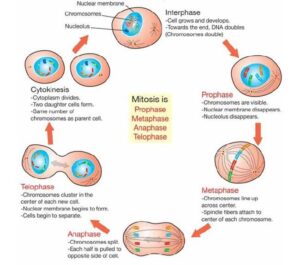 The cell, the basic unit of life, goes through the cell cycle, which is a precisely regulated and well-organized series of activities. This complicated dance of cellular life is essential to living creatures’ growth, development, and reproduction. Let’s take a detailed look at the fascinating mechanisms of the cell cycle and division.
The cell, the basic unit of life, goes through the cell cycle, which is a precisely regulated and well-organized series of activities. This complicated dance of cellular life is essential to living creatures’ growth, development, and reproduction. Let’s take a detailed look at the fascinating mechanisms of the cell cycle and division.
An Overview of the Cell Cycle
The cell cycle is a dynamic and cyclical process that guides eukaryotic cells from birth to growth, replication, and eventual division. It is a finely controlled system that ensures that genetic information is faithfully transmitted to daughter cells.
The Prolific Preparation Phase Interphase
Interphase accounts for over 90% of the cell cycle and is separated into three stages: G1 (Gap 1), S (Synthesis), and G2 (Gap 2). During G1, the cell develops and performs its normal tasks. The S phase is distinguished by DNA replication, which involves the reproduction of genetic material. The cell goes through final division preparations in G2, screening for any faults in DNA replication and ensuring that all cellular components are in good working order.
Mitosis: The Magnificent Divisional Performance
Mitosis, the cell cycle’s grand finale, is broken into four stages: prophase, metaphase, anaphase, and telophase. Chromatin condenses into visible chromosomes during prophase, the nuclear membrane dissolves, and the mitotic spindle machinery forms. The alignment of chromosomes at the cell’s equator occurs during metaphase, guaranteeing an equitable distribution of genetic material. Sister chromatids separate and travel to opposing poles of the cell during anaphase, and telophase marks the culmination, with the development of two different nuclei.
Cytokinesis: The Final Stage of Cellular Division
After the spectacle of mitosis, the cell completes its division during cytokinesis. A cleavage furrow arises in animal cells, pinching the cell into two daughter cells. Plant cells, on the other hand, develop two different cells by forming a cell plate halfway. This final operation ensures that the cellular division process is completed.
Interphase’s Role in Cellular Homeostasis
Interphase is far from passive, despite its reputation as a resting phase. G1 is a development phase during which the cell actively executes its normal duties. S phase is essential for DNA replication because it lays the groundwork for the genetic material required in following cellular processes. G2 ensures that the cell is appropriately prepared for mitosis, hence maintaining cellular homeostasis.
Mitosis and Growth: A Mutually Beneficial Relationship
Mitosis is essential for the formation of multicellular organisms. Mitotic division increases the number of cells, which aids in the development and enlargement of tissues and organs. This process is especially important during growth stages such as embryonic development and adolescence.
Cellular Repair via Mitosis
Mitosis is required not just for growth but also for the repair of damaged tissues. Mitotic division replaces cells that are wounded or lost, facilitating tissue regeneration and general organismal health. This regenerative capacity is critical for the body’s structural integrity to be maintained indefinitely.
The Precise Art of DNA Replication: Genetic Stability
Maintaining genetic stability is critical to the cell cycle. Errors in DNA replication can result in mutations, which can lead to genetic diseases or the development of cancer. To ensure the correctness of DNA replication and the integrity of genetic material, the cell has evolved complicated systems, including multiple checkpoints.
Checkpoints: Cellular Integrity Defenders
Various checkpoints, which operate as guards, assessing the cell’s readiness to advance to the next phase, are critical to the cell cycle’s faithfulness. These checkpoints, which are located at the end of G1 before entering S phase and at the G2-M transition, act as surveillance systems, ensuring that the cell’s DNA is intact and ready for division.
Cell Cycle Aberrations as a Threat to Cellular Harmony
While the cell cycle is a highly regulated process, errors can occur, disrupting cellular equilibrium. Tumors and malignancies can emerge as a result of uncontrolled cell division. Understanding these deviations reveals prospective therapeutic methods for diseases caused by cellular dysregulation.
At the molecular level, the cell cycle and division form an exquisite symphony of life. These processes assure the continuation, growth, and integrity of life, from the dynamic preparations of interphase to the magnificent spectacle of mitosis and the culminating act of cytokinesis. We gain a profound appreciation for the intricacy of cellular biology as we delve into the specifics of the cell cycle, as well as insights into new routes for treating and preventing diseases caused by cellular dysregulation.


















